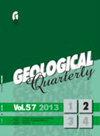捷克喀尔巴阡山前渊中新世沉积岩的烃源岩潜力
IF 0.7
4区 地球科学
Q3 GEOLOGY
引用次数: 0
摘要
我们确定了捷克喀尔巴阡山前深部中新世沉积岩的有机质含量、热成熟度、成因类型和烃源岩潜力。在捷克共和国,喀尔巴阡山前深部代表了一个外围前陆盆地,该盆地是由于阿尔卑斯喀尔巴阡逆冲楔的构造侵位和加载到波西米亚地块的被动边缘而形成的。对喀尔巴阡山前深序列的25个样品进行了随机镜质组/腐殖组反射率测量和显微组分分析。此外,135次TOC含量测量、141次岩石蒸发热解分析和27次镜质组反射率测量的结果被用于评估整个喀尔巴阡山前深部的区域分布和深度趋势。有机物的热成熟度介于未成熟部分和油窗峰值之间(Tmax=413–448°C)。在西喀尔巴阡冲断带之下,热成熟度达到更高的值(Rr=0.43–0.58%,Tmax=429–448°C)。即使总有机碳值表明良好甚至非常好的烃源岩潜力,生烃潜力也很差或尚可。这主要是由于主要的III型干酪根易于产生气体。在所讨论区域的南部和中部的中新世地层中观察到了最佳烃源岩。本文章由计算机程序翻译,如有差异,请以英文原文为准。
Source rock potential of the Miocene sedimentary rocks in the Carpathian Foredeep of the Czech Republic
We determine the organic matter content, its thermal maturity, genetic type, and source rock potential of the Miocene sedimentary rocks in the Czech Carpathian Foredeep. In the Czech Republic the Carpathian Foredeep represents a peripheral foreland basin formed due to the tectonic emplacement and loading of the Alpine-Carpathian Thrust Wedge onto the passive margin of the Bohemian Massif. Random vitrinite/huminite reflectance measurements and maceral analyses were performed on 25 samples from the Carpathian Foredeep succession. Additionally, results of 135 TOC content measurements, 141 Rock-Eval pyrolysis analyses and 27 vitrinite reflectance measurements were used to evaluate the regional distribution and depth trends for the entire Carpathian Foredeep. The thermal maturity of organic matter is between the immature part and peak of the oil window (Tmax = 413–448°C). Beneath the Western Carpathian Thrust Belt, the thermal maturity reaches higher values (Rr = 0.43–0.58%, Tmax = 429–448°C). The hydrocarbon generation potential is poor or fair, even if the total organic carbon values indicate good or even very good source rock potential. This is mainly due to the prevailing gas-prone Type III kerogen. The best source rocks were observed in the Miocene strata of the southern and central segments of the area discussed.
求助全文
通过发布文献求助,成功后即可免费获取论文全文。
去求助
来源期刊

Geological Quarterly
地学-地质学
CiteScore
2.20
自引率
0.00%
发文量
19
审稿时长
>12 weeks
期刊介绍:
The policy of the Geological Quarterly is to publish significant contributions of information and geological insight relevant to an international readership. The journal has been issued since 1957 at the Polish Geological Institute - National Research Institute and, at present, is the leading Earth sciences journal in Poland. All aspects of Earth and related sciences, and universal and broad regional rather than locally oriented topics are covered.
The journal is intended to be an international forum for the exchange of information and ideas, particularly on important geological topics of Central Europe.
 求助内容:
求助内容: 应助结果提醒方式:
应助结果提醒方式:


